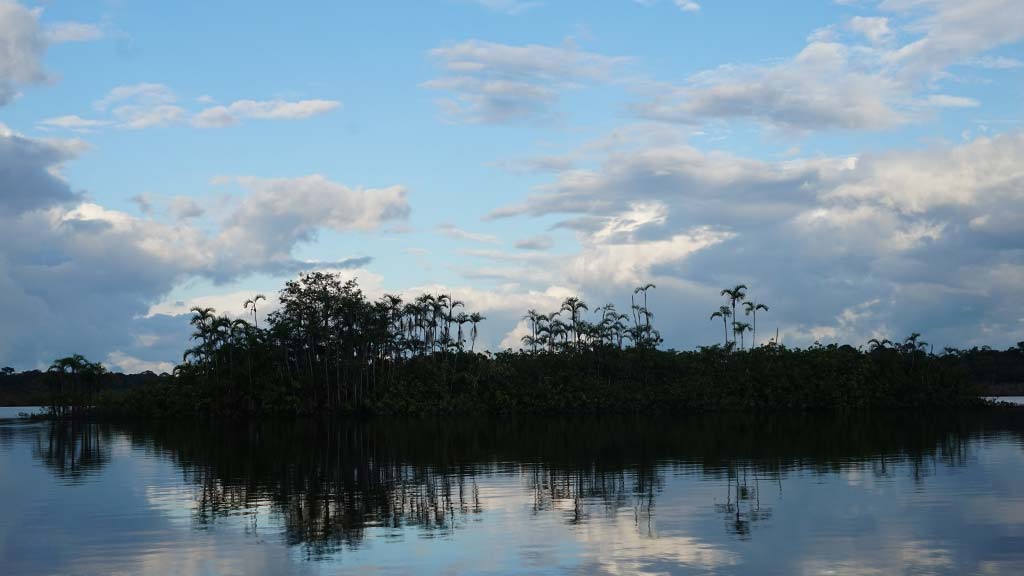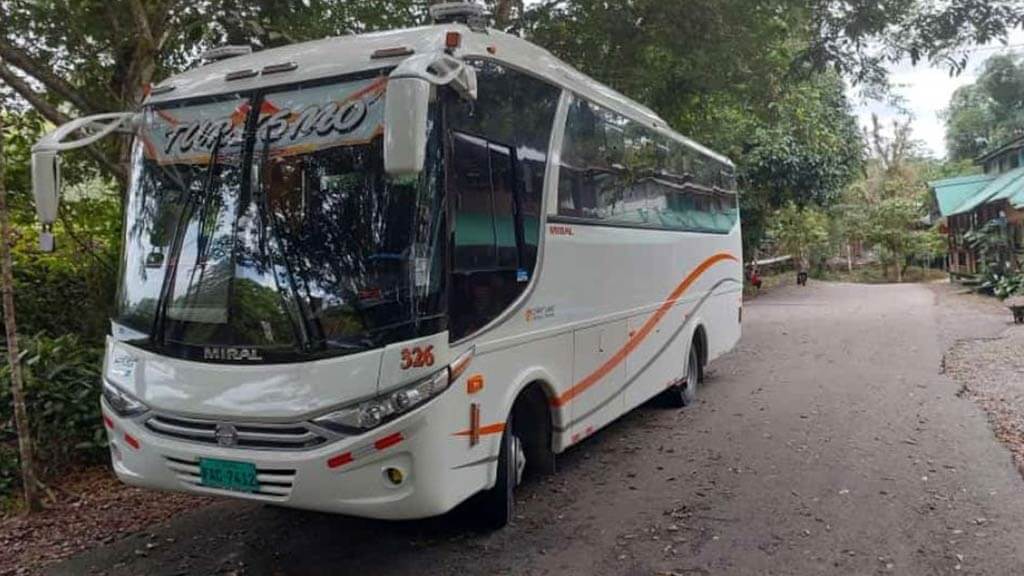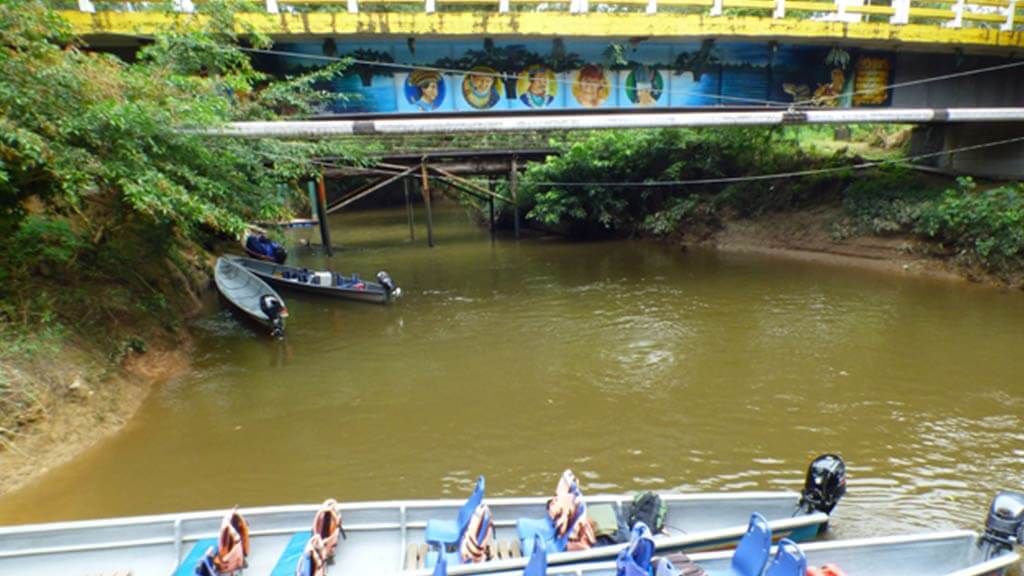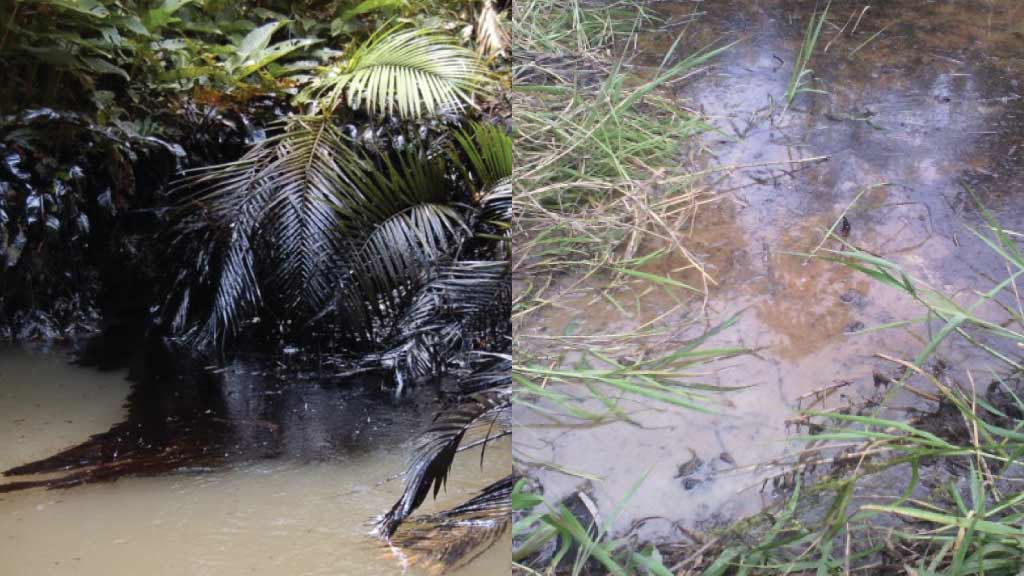Cuyabeno Wildlife Reserve
Ready to embark on a wild adventure deep into the heart of the Amazon Rainforest? Well, don your explorer's hat because we're about to dive headfirst into the lush paradise of the Cuyabeno Wildlife Reserve.
Not only is Cuyabeno Ecuador one of the most popular regions of the Amazon to visit, but it’s also accessible and affordable. At Cuyabeno, pristine nature awaits the intrepid visitor. The incredible biodiversity of birds, animals, and plant species is hard to beat, including the famous Cuyabeno pink river dolphin. You’ll also come face to face with colorful Indian tribes, and can chance your arm at piranha fishing!
Keep reading for the ultimate visitor guide to Ecuador’s spectacular Cuyabeno Wildlife Reserve. We include everything you’ll need to make your Cuyabeno Rainforest trip a success - from trip planning to packing lists, top tips, and travel practicalities.
So, my fellow explorers, are you ready to let your wanderlust run wild? Stay tuned as we embark on a virtual journey that promises to leave you inspired, awestruck, and yearning for your very own adventure into this untouched slice of heaven – the Cuyabeno Reserve.
SECURE YOUR AMAZON TRAVEL
Get a FREE personalised quote today
Everything You Need to Know About Cuyabeno Ecuador
Before we get into the nitty-gritty of how to visit, let’s kick off with some fast facts about Cuyabeno Reserve.
Cuyabeno Wildlife Reserve Facts
Provinces: Orellana & Sucumbios
Created in: 1979.
Area: 590,112 hectares (5,900 km2 or 2,330 square miles).
Altitude: ranging from 177 to 326 meters above sea level.
The Cuyabeno Wildlife Reserve (in Spanish: Reserva de Producción Faunística Cuyabeno) is the second largest protected area of the 56 different national parks and reserves in Ecuador.
Cuyabeno fun fact: In the local Siona-Secoya language, Cuyabeno means "Kindness River".

Where Is Cuyabeno?
Cuyabeno is located in the Amazon rainforest region of Ecuador, to the east of the Andean mountain range which slices the country down the middle. Every drop of water that falls on this side of the Andes works its way into the Amazon River basin, eventually flowing out into the Atlantic Ocean.
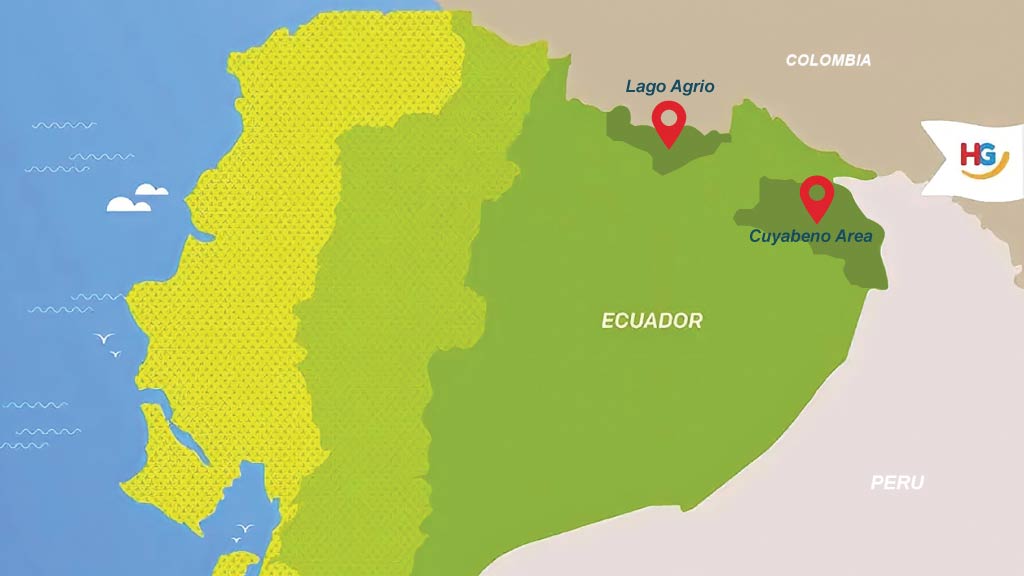
The Cuyabeno Reserve lies close to Ecuador’s border with Colombia. The reserve includes water basins of three important rivers: Cuyabeno, Lagartococha, and Aguarico, all of which form part of the mighty Amazon River Basin.
Although just over 300km away from Ecuador’s capital city, Quito, it does take quite a journey to reach Cuyabeno. Of course, though, the journey is always part of the adventure, with wonderful forest views to enjoy along the way.
What Makes Cuyabeno Reserve So Special?
The Cuyabeno Reserve boasts a mesmerizing mosaic of ecosystems, from narrow, winding waterways to untouched primary rainforests, creating a haven for an astounding variety of flora and fauna. Cuyabeno is a grand showcase of biodiversity and Mother Nature's creativity.
Okay, that all sounds great, but there are lots of other areas of South America’s Amazon that could make the same claims.
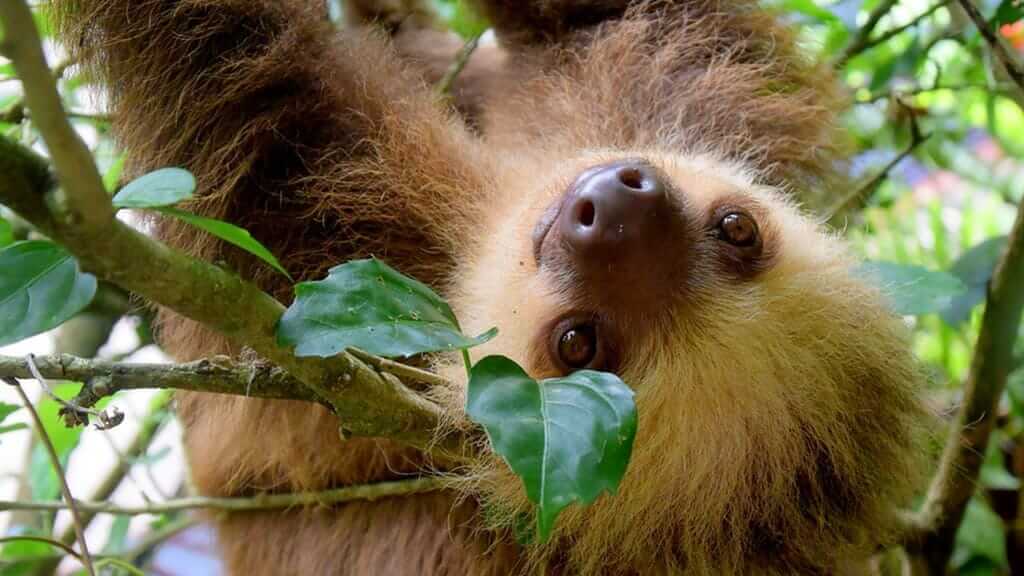
So, what’s so unique about Cuyabeno?
The Cuyabeno Reserve is in fact different from any other area of the Amazon Rainforest in South America. Cuyabeno is a flooded Amazon forest and the most extensive wetlands of Ecuador’s Amazon. Here, water replaces terra-firma, and rivers become narrow canals & streams that drain into swamps and large lagoons. The canoe is the only way to get around.
The flooded forest wetlands habitat is rare so close to the Andes. Usually, drainage in the Andean foothills prevents the development of swamps and lakes. Cuyabeno is home to dark-water rivers, often brown and black in color due to the presence of decomposing vegetal material.
Visitors to Cuyabeno Ecuador thus get a great combo. Firstly, access to a fairly unique jungle ecosystem not found in other parts. Secondly, the opportunity to spot some cool wildlife like the pink river dolphin, black caiman, and piranha fish.
How to visit Cuyabeno Reserve Ecuador?
Getting to Cuyabeno is not quick or easy, but there’s no doubt that the rewards far outweigh the effort.
Keep reading to learn the various Cuyabeno transportation options that are available, as well as the best Cuyabeno lodges to stay at.
How do I get to Cuyabeno Reserve?
To visit Cuyabeno visitors first need to head to the jungle town of Lago Agrio (confusingly sometimes also referred to as Nueva Loja). Most Cuyabeno lodges then provide onward transportation to Cuyabeno Bridge by local bus, and into the reserve via motorized canoe.
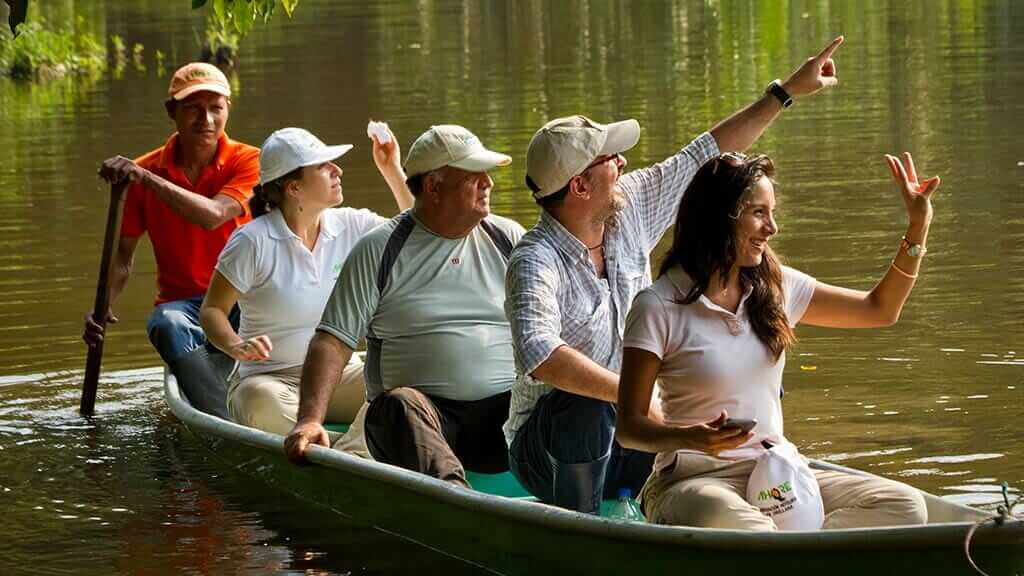
1. Bus Quito – Lago Agrio
The Quito to Lago Agrio bus ride takes approx 8-10 hours in total. It’s best to take a night bus (leaving between 10 pm and midnight), although it’s no easy feat to fall asleep along the windy roads.
Most visitors take the private tourist bus ($22 per person) departing from the old town of Quito. Although pricier than the regular public bus ($10 per person), the onboard security is better, and you’ll avoid a taxi ride across Quito to the Quitumbe Bus Terminal. Cuyabeno lodges can help in advance with private bus reservations.
Can I fly from Quito to Lago Agrio? At the time of writing, unfortunately, the answer is NO. The Quito to Lago Agrio flight route ceased to operate during the Covid pandemic and has not yet started up again. It is possible to fly instead into the town of Coca, but you’ll then need bus transportation onto Lago Agrio (approx 2 hours journey).
2. Bus Lago Agrio to El Puente Cuyabeno
Cuyabeno lodges meet passengers at various pickup points in Lago Agrio town for the onward journey to Cuyabeno.
Your destination is the bridge (El Puente) over the Cuyabeno River, 100 km away. El Puente is the control checkpoint to enter the Cuyabeno Reserve.
3. Canoe Ride from El Puente to Cuyabeno Lodges
From El Puente, your lodge tour guide will organize the final step of the journey to Cuyabeno. You’ll board a motorized canoe together with the rest of your group, and navigate downriver to Cuyabeno’s Laguna Grande. The canoe ride usually takes 1 and ¾ hours, depending on the river´s water level. Most Cuyabeno lodges are located on or around Laguna Grande.

Cuyabeno Lodges & Tours
99% of Cuyabeno tourists pre-book an organized tour. This is an attractive option as permissions, canoe transfers, guide, and accommodation already come included in the package. With one simple booking everything is organized, so you can look forward to a fun trip without any hassles.
In reality, all lodges offer a very similar tour experience, with much the same activities and visits included. The main difference between them is in comfort and service level. Whichever Cuyabeno Lodge you choose, an unforgettable experience with nature deep inside the Cuyabeno Reserve is guaranteed.
To make life easier, we’ve prepared a list of our top 3 Cuyabeno lodge recommendations.
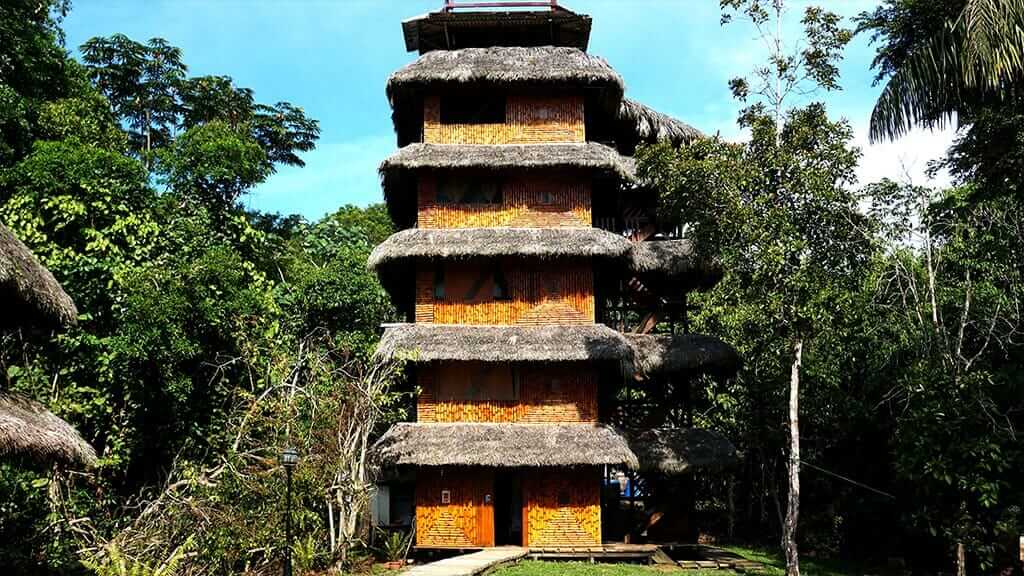
1. Caiman Lodge, Cuyabeno
Caiman Lodge is our most popular budget-friendly Cuyabeno tour! We frequently receive glowing feedback from this tour.
While the lodge is certainly rustic, they do have a relaxing social area with hammocks, plus an amazing canopy tower affording great views over the lagoon and the Cuyabeno jungle from the top floor.
For adventurous spirits who enjoy meeting like-minded travelers, and those who are not bothered about creature comforts, the Caiman Lodge in Cuyabeno Reserve is a great choice.
2. Siona Lodge, Cuyabeno
Siona Lodge is a nice choice for visiting Cuyabeno in more a little comfort than the regular backpacker lodges, whilst still being budget-friendly.
Located on Laguna Grande, you’ll find comfortable cabins, and spacious social areas including balconies with hammocks and lounge chairs, and a bar serving after-dinner cocktails.
Siona Lodge is also often more quiet than the busier backpacker Cuyabeno lodges, so can be a great option to enjoy the forest in more solitude.

3. Jamu Lodge, Cuyabeno
Jamu Lodge is located 15 minutes downstream from Laguna Grande, offering some privacy away from other Cuyabeno lodges.
Jamu is suitable for both budget and comfortable travelers. They offer both standard and more expensive upgraded suite cabins, all built in a traditional, rustic style with high thatched roofs.
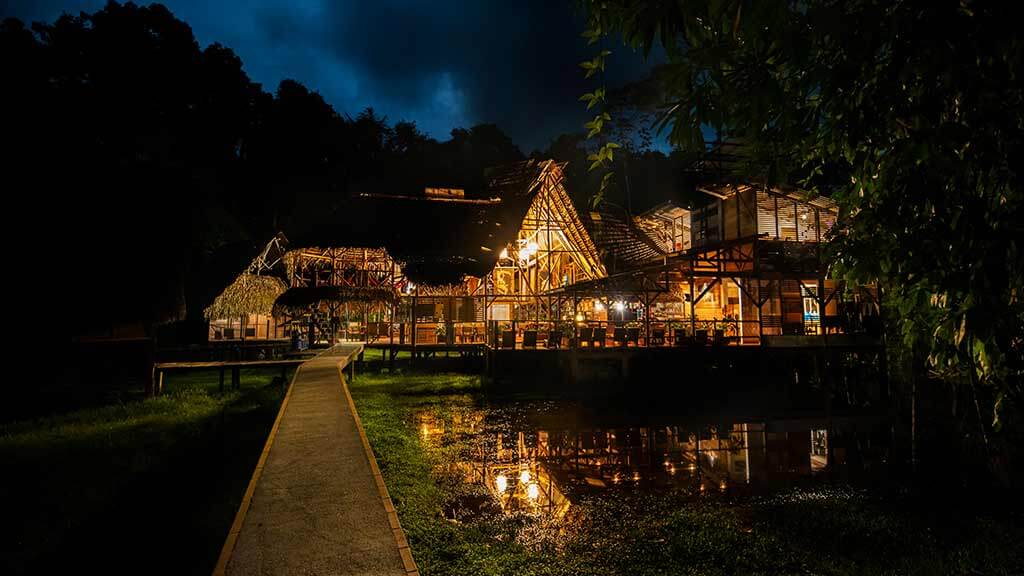
GET FREE ADVICE
From an Amazon destination expert todayThings to do in Cuyabeno Wildlife Reserve
For those who love the great outdoors, the Cuyabeno Reserve is a giant playground with something for just about everyone to enjoy.
1. Cuyabeno Wildlife Watching
Without a doubt, the number one reason to visit Cuyabeno Reserve is wildlife watching. With a good pair of binoculars or zoom camera, Cuyabeno certainly doesn’t disappoint - the diversity of fauna is truly outstanding!
So, which different birds & animals call Cuyabeno Wildlife Reserve home?
How about 10 different monkey species of monkey, including spider, wooly, howler, squirrel, and cute capuchin monkeys. Other mammal species you could cross paths with include, tapir, wild boar, deer, sloth, capybara, anteaters, otters, armadillos, rodents, and bats
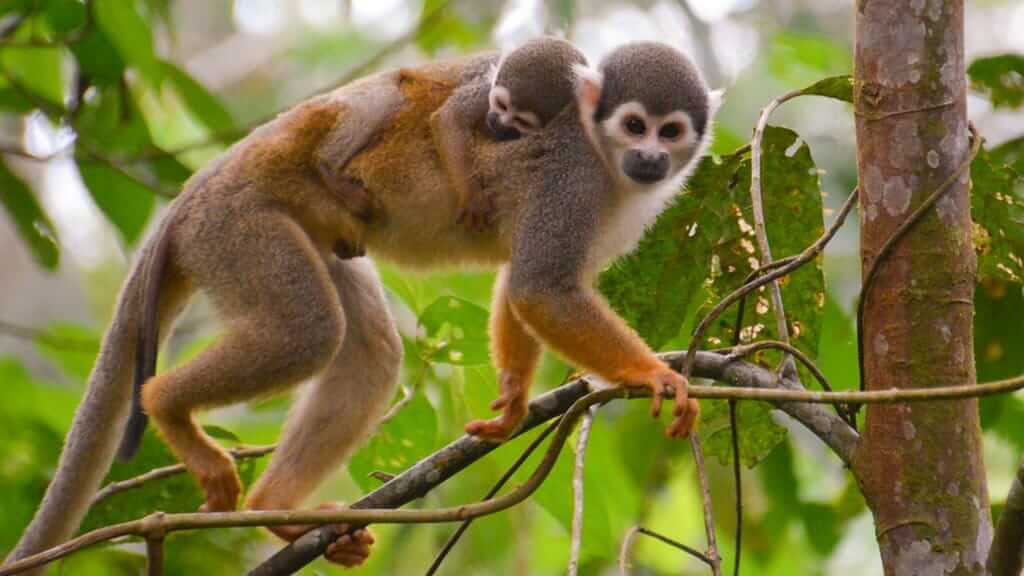
Now, let's talk about the big cats that prowl in the shadows. Both jaguars and puma call Cuyabeno home. While spotting one is like finding a needle in a haystack, the thrill of knowing they're out there, living their wild lives, is a rush of excitement in itself. Keep your fingers crossed and your camera ready – you just might be in for a once-in-a-lifetime sighting.
Don’t forget, that Cuyabeno is a flooded forest ecosystem. The black water lagoons and streams are the perfect hiding place for black caiman alligators, boas, and anacondas – pound for pound the largest snake on the planet. Other reptiles in Cuyabeno waters include turtles, smaller snakes, frogs, and even piranha.

Let’s not forget about rainforest insects. OK, so creepy crawlies might not be your thing, but seriously, who doesn’t love little leaf-cutter ants?
Last but certainly not least, Cuyabeno is also home to the Pink River Dolphin, a creature so rare and exciting that we think it deserves its very own category …
2. Spot a Pink River Dolphin
The Amazon Pink River Dolphin is one of the world’s rarest dolphin species. For those looking to see them up close and personal, the Cuyabeno Wildlife Reserve is a must-visit destination and one of the best places to spot them in the South American Jungle.
The Amazon River Dolphin (Inia Geoffrencis) is the largest river dolphin species on the planet, reaching 2.5 meters in length, and weighing up to 185 kg. They are listed on the IUCN Red List as an Endangered Species with a declining population trend.
And here's a fun Cuyabeno River Dolphin fact: their natural color is in fact grey. The famous pink hues are activated when they are most active, usually during fishing, playing, or mating. How do they do this? Amazon River Dolphins have a unique cooling system. They can regulate body temperature by sending blood closer to the water via veins and blood vessels located near their skin.

3. Cuyabeno Bird Watching
Cuyabeno also has plenty of action for birders. Home to over 550 bird species, birding enthusiasts are in for a treat. Non-birders will also enjoy this activity, as many Amazon bird species are colorful, exotic, and unusual.
Your naturalist guide will be happy to point out toucan, macaw, parrot, woodpecker, and birds of prey up in the canopy. Meanwhile, at ground level, hummingbirds flit between flowers, tinamou scurry through the foliage, and prehistoric-looking hoatzin birds squawk for attention. Kingfishers, flycatchers, and waders are common sightings along river and lake shores.
On a single multiday Cuyabeno trip, it’s possible to tick off hundreds of different bird species.
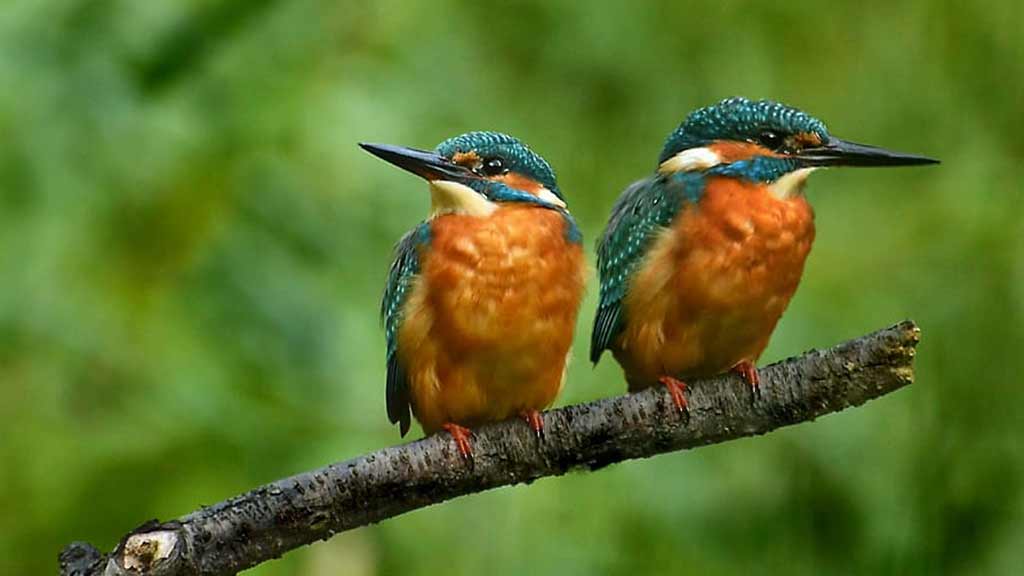
4. Immersion In Nature - Plants & Trees
Nature lovers can also appreciate the incredible plant life found in Cuyabeno Reserve.
Look out for the Water Guarango Tree, the most unique tree in this reserve with special adaptations that allow it to grow on the swampy shores of rivers and lagoons.
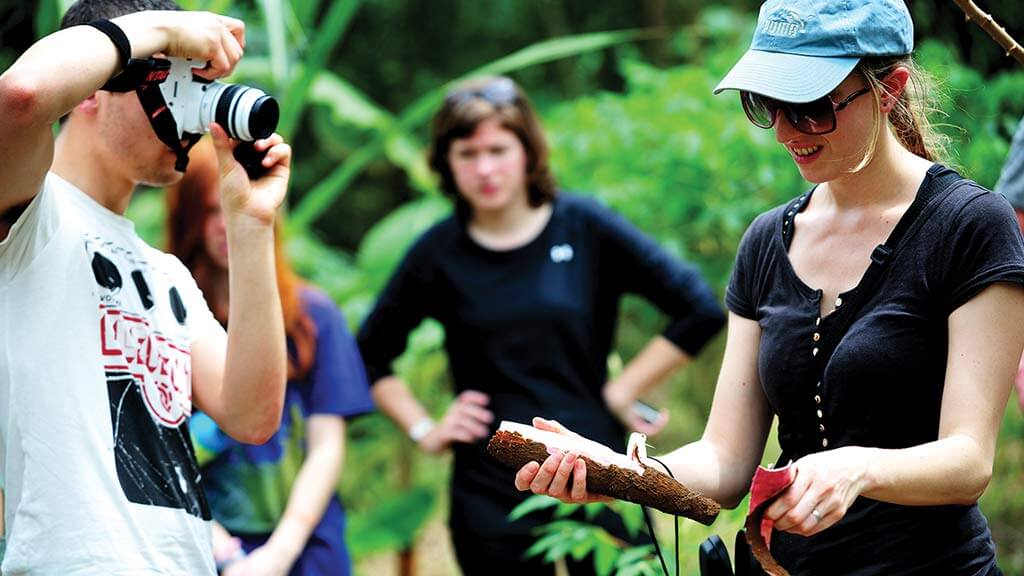
For me, a big part of any visit to the rainforest is about learning and education. Understanding the incredible connections that different rainforest plants share. Learning how local cultures live in harmony with the forest, to provide food and shelter. Discovering medicinal plants and bush tucker, the secret knowledge of forest dwellers.
The Cuyabeno Reserve is also about connection. A portal into our own past, to times before we decided to chop forests down. A deep immersion into the values of mother nature, and a glimpse of the natural harmony and tranquility we have learned to live without in the city. A first-hand experience to understand the damage humans cause to nature, and the stirring of a strong desire to live better.
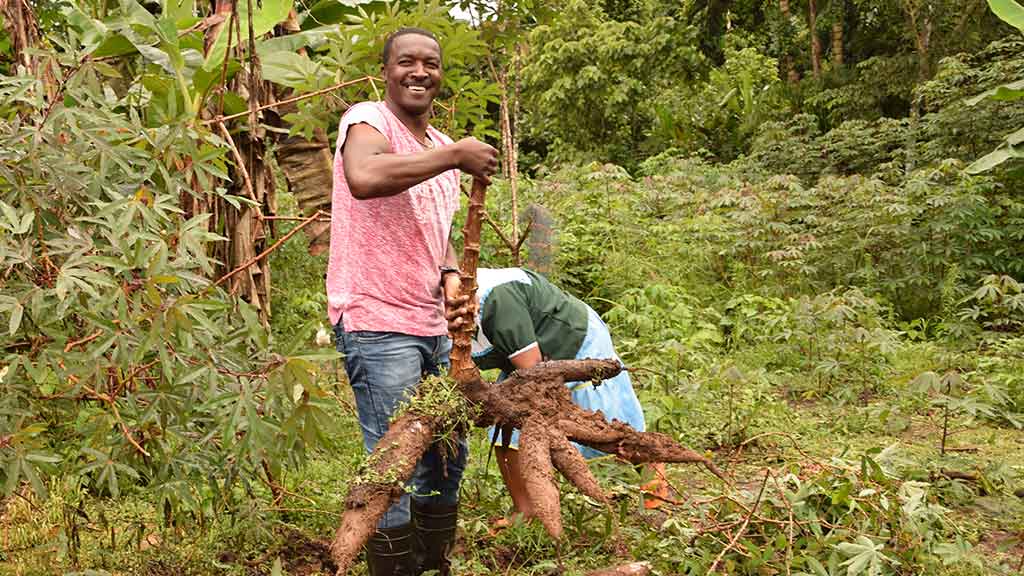
The rainforest is also a lesson in perspective. From the unfathomable macro expanses of green from the canopy tower to the micro beauty of each tiny plant and insect. The Amazon ecosystem is more immense than one can imagine, yet at the same time, the forest’s secrets are there waiting to be discovered.
5. Forest Hiking
Depending on the season, a great way to get to know Cuyabeno’s forest is to pull on a pair of rubber boots, and hit the trails.
Relying on the keen eyesight of your native guide, the forest begins to reveal her secrets. Discover which plants are edible, as food or medicine, and which contain deadly poisons. Learn how to use palms to weave a basket on the go, or to thatch hut roofs. Find the Sangre de Drago tree (dragon’s blood) – whose sap is famed for sealing open cuts and healing wounds.
Basic tracking skills can also be developed, to identify which jungle creatures crossed the jungle trail before you. There’s also a whole world of fascinating ants and bugs waiting to be discovered at ground level.
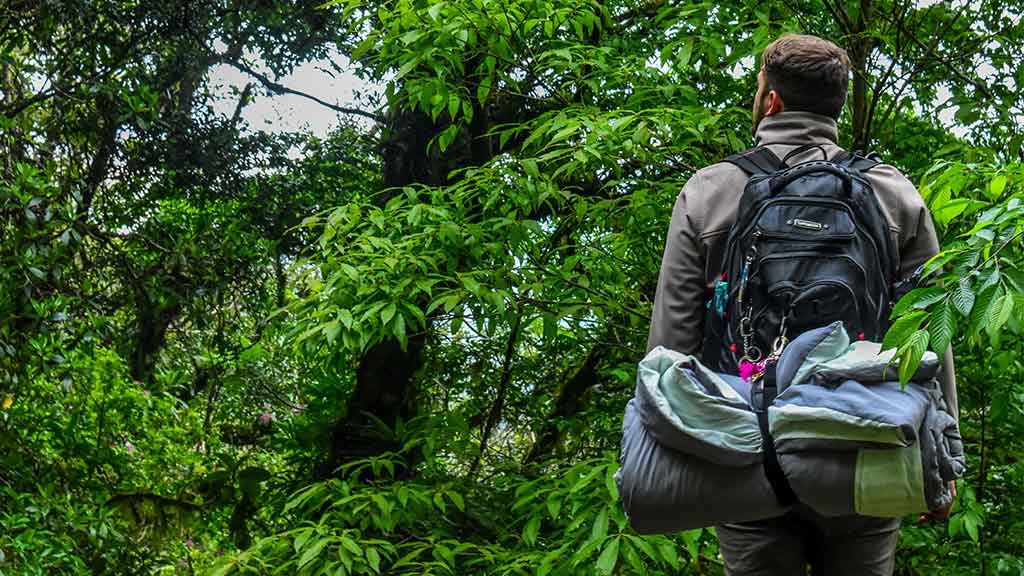
6. Canoe Navigation
Paddling in dug-out canoes is often the best opportunity to spot Cuyabeno wildlife in the forest. Cuyabeno is of course famous for its narrow, ever-changing waterways that link the larger lagoons.
Rivers and streams are the roads of the Amazon. Many birds and animals prefer to hang out by river banks or lake shores, where feeding requires less effort. Unlike exploration on foot, the canoe glides gently and silently into their world. Camera and binoculars at the ready, the dugout canoe is an Amazon safari like no other.
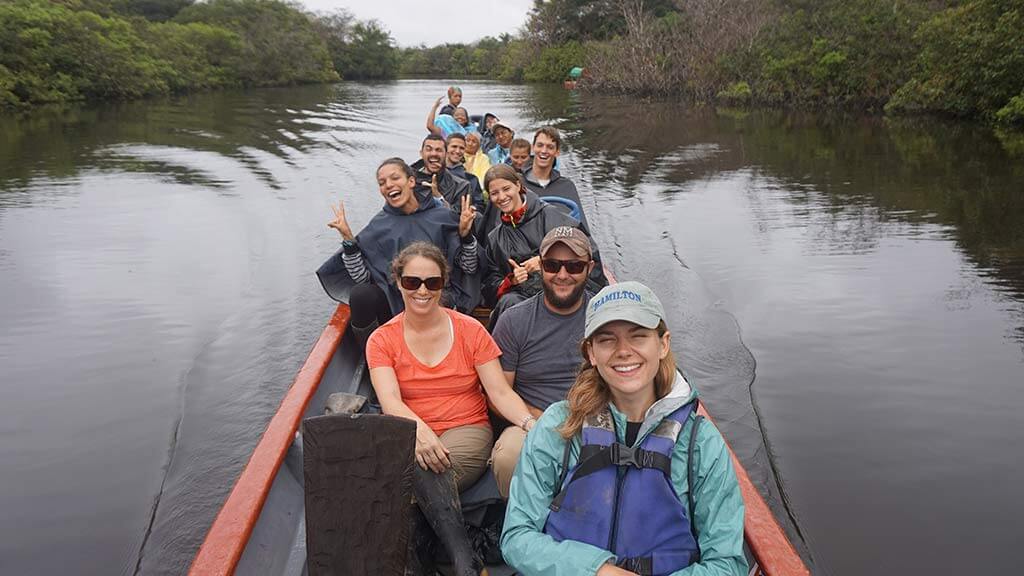
7. Experience Cuyabeno Tribal Culture
Cuyebeno is as rich in tribal culture as it is in wildlife. No visit to Cuyabeno would be complete without a visit to a local jungle community. Fortunately, most Cuyabeno lodge tours offer this exact opportunity. A chance to learn about culture, traditions, and unique ways of life in the Amazon.
Today, Cuyabeno is home to no fewer than 5 different indigenous tribes: Siona, Secoya, Cofán, Quichua, and the Shuar. A visit to an indigenous community usually involves experiencing food, dance, and local customs.
Often there is also the opportunity to meet a shaman healer, learn about his role in the community, and perhaps partake in a spiritual cleansing ritual
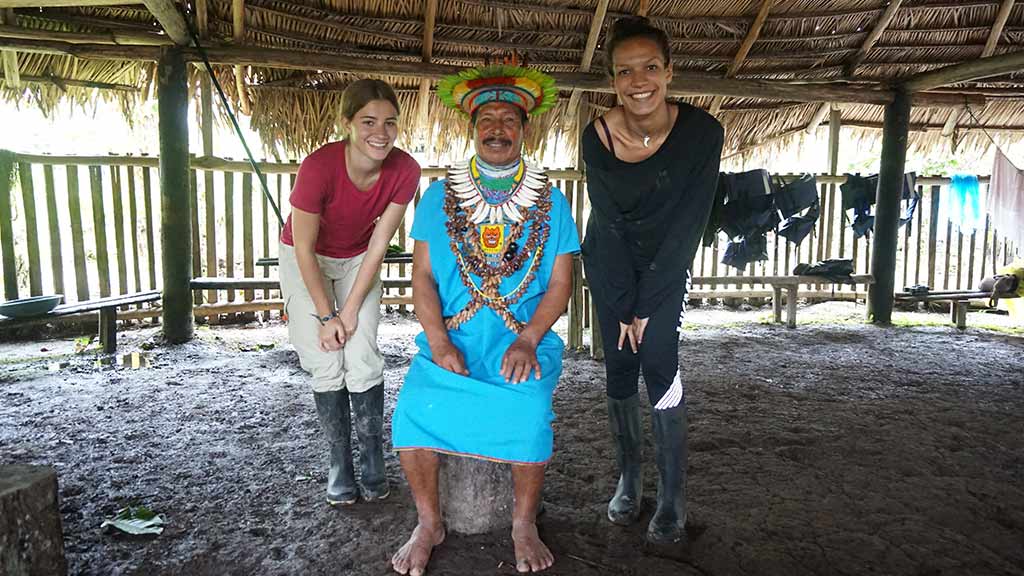
8. Check Out Canopy Views
Staying at a lodge with an observation tower is undoubtedly a big plus. The views of the forest from atop a tower provide an excellent contrast to ground level and a whole new perspective of the Amazon. With the dense forest stretching out before you, the canopy is home to many bird species and also makes sloth and monkey spotting easier.
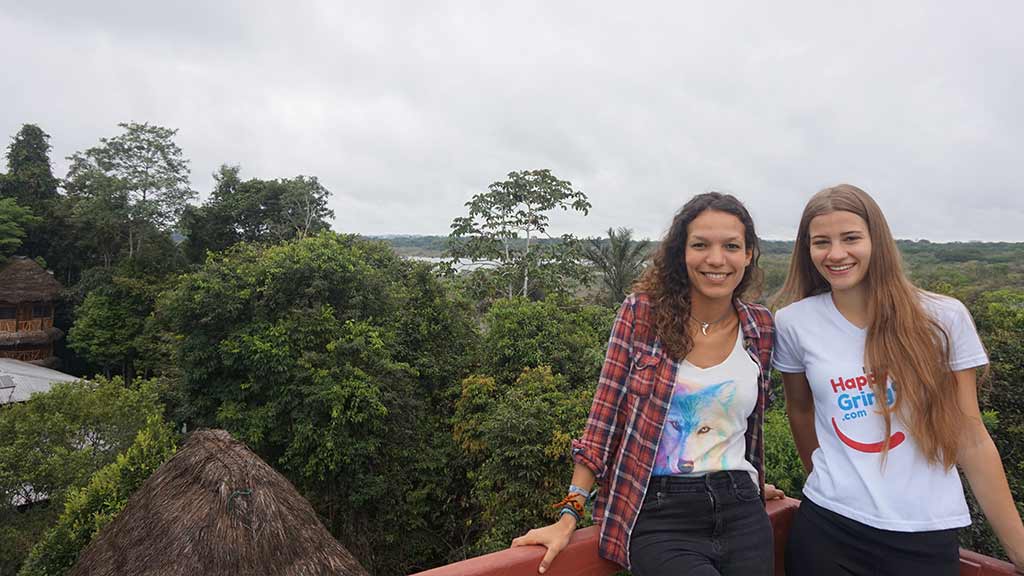
9. Piranha Fishing
Piranhas – those sharp-toothed, fearsome fish that have sparked countless stories and myths. Well, guess what? They're very much real, and they call the waters of Cuyabeno home. Imagine yourself on a rustic canoe, your fishing rod in hand, as you navigate the labyrinthine waterways in search of these intriguing creatures.
As you drop your bait into the water, a sense of anticipation hangs in the air. Will you feel that telltale tug? Will you get a chance to test your angling skills against one of the Amazon's most notorious predators? It's a game of patience and strategy, where every movement of your rod sends ripples of excitement through the stillness of the rainforest.

And when you do feel that bite, hold on tight! Piranhas are known for their fierce nature and powerful jaws. Landing one requires a mix of finesse and quick reflexes, as these sharp-toothed swimmers can put up quite the fight. But fear not – your expert guides will be there to show you the ropes and ensure a safe and unforgettable experience.
Don't worry, piranhas might have a reputation as fearsome predators, but they're actually a crucial part of the ecosystem. These scavengers help keep the rivers clean by feeding on carcasses and sick fish, playing a role in maintaining the delicate balance of the Amazon's aquatic world.
Of course, this is catch-and-release fishing, so we’ll be leaving no footprints.
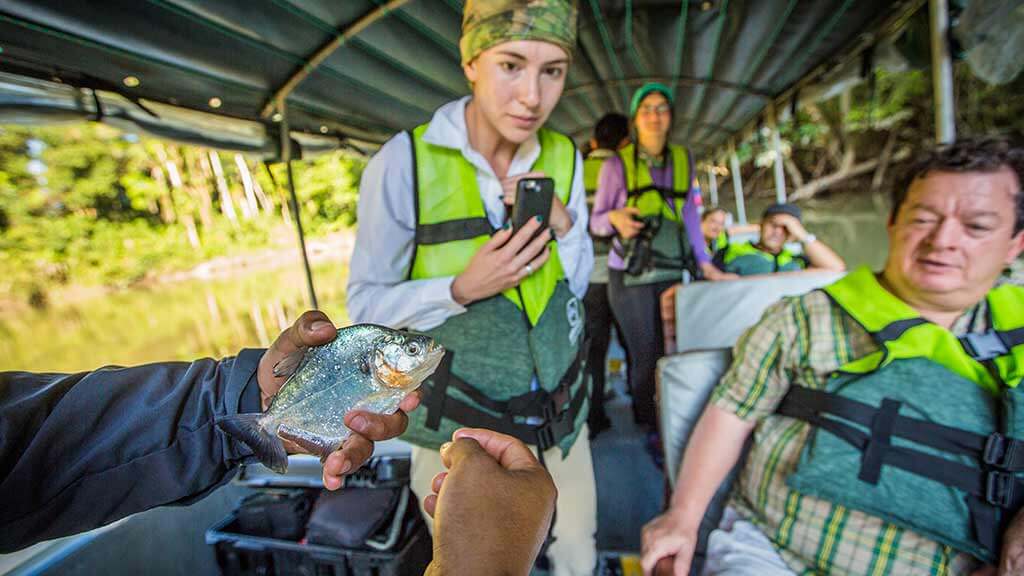
What Are The Threats to Cuyabeno Reserve?
While this slice of natural heaven might seem untouched and timeless, it's not immune to the challenges that modern times bring. So, let’s into the conservation concerns facing Cuyabeno Reserve.
1. Deforestation: As our world evolves, so does the demand for resources. And unfortunately, the lush rainforests of Cuyabeno aren't exempt from deforestation. The clearing of land for agriculture, illegal logging, and other development projects poses a significant threat to the delicate balance of the Cuyabeno ecosystem.
2. Oil Extraction: Cuyabeno's proximity to oil-rich areas means that the potential for oil extraction is a looming threat. The environmental impact of such activities can be devastating, from habitat disruption to water pollution.
3. Hunting and Poaching: While regulations exist to protect the reserve's wildlife, illegal hunting and poaching still pose a serious risk. Animals like jaguars, pink river dolphins, and tapirs are all targets for their valuable parts in Chinese medicine.
4. Climate Change: This global concern doesn't spare even the most remote corners of the Earth. Climate change can affect rainfall patterns, temperatures, and overall ecosystem health. Such changes can disrupt the behavior of wildlife and alter the very landscapes that make Cuyabeno so breathtaking.
5. Tourism Impact: While responsible tourism can be a boon for conservation efforts, irresponsible practices can have negative consequences. Improper waste disposal, disturbance of wildlife, and habitat destruction can occur if not monitored carefully. Fortunately, Cuyabeno tourism is carefully managed today, and the volume of visitors is manageable. The responsible actions of today’s tourists will help ensure that Cuyabeno can still be enjoyed by future generations
The good news is that efforts are being made to address these challenges head-on. Conservation organizations, local communities, and ecotourism initiatives are working together to safeguard the Cuyabeno Wildlife Reserve. By raising awareness, supporting sustainable practices, and advocating for the preservation of this precious haven, we can contribute to the ongoing effort to protect this incredible natural treasure.
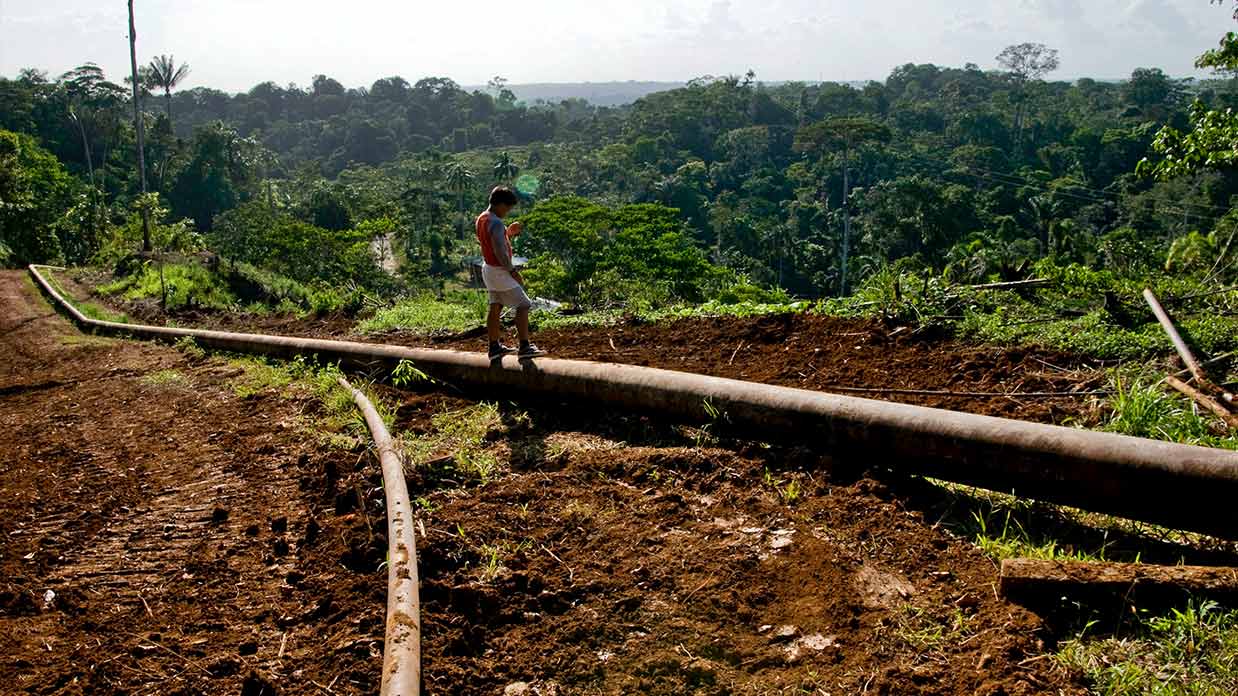
Typical Cuyabeno Weather
The weather in Ecuador’s Cuyabeno region of the Amazon is broadly defined by 3 different seasons – wet, dry, and in-between. There is no “best” time to visit per se, as each season has pros and cons to consider.
Rainy season – Cuyabeno receives most rain from February to April. But, in some ways, the season name is misleading as it does actually not rain all day every day, but heavy showers are to be expected. The advantages of travel during the wet season are higher river levels and slightly cooler temperatures although still in the mid to high 20s degrees celsius.
Dry season lasts more or less from May to October, with the months of July, August, and September receiving the lowest rainfall. Of course, this is the rainforest, so still expect precipitation, but usually less than the rainy season. The plus side is that rain is less likely to interrupt activities, however, visitors will have lower river levels to deal with, which can make canoe navigation more complicated. Temperatures and humidity are also higher, passing a high of 30+ degrees celcius on most days.
Shoulder season is defined by the remaining months of the year – November, December, and January. These months bring more unpredictable weather patterns, so expect a mix of rain and sun, with variable temperatures.
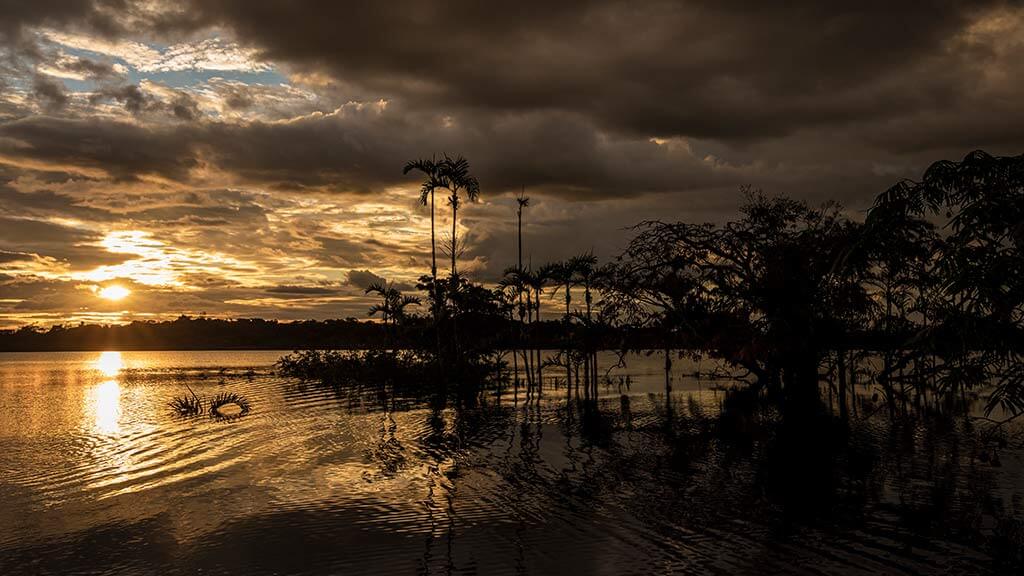
Practicalities For Visiting Cuyabeno Reserve
- Recommended Vaccinations to enter Cuyabeno are yellow fever and tetanus. At the time of writing full Covid vaccination is also required.
- Malaria medication is recommended, although it’s best to consult with your doctor before you travel. Bug spray is a must to prevent mosquito bites in the first place, and most lodges provide mosquito netting over beds.
- Packing List – Be sure to go well prepared as there are no shops in the jungle. Check out our handy Amazon packing list blog for packing tips.
- Most lodges will provide rubber boots and rain ponchos for jungle activities. Life jackets are also available on canoe trips.
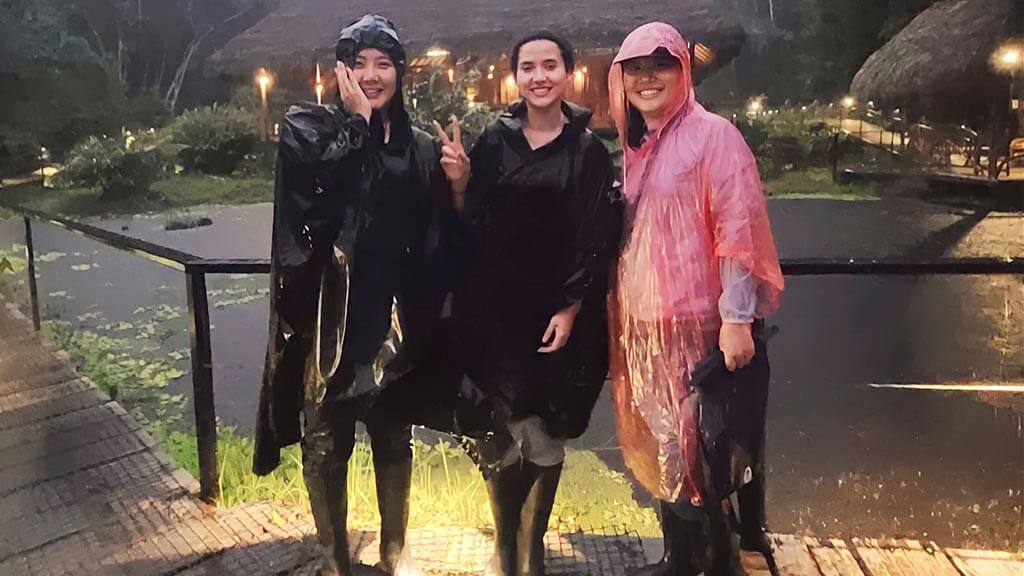
- A camera with a good zoom lens and/or binoculars is highly recommended to catch the best Cuyabeno wildlife views. A dry bag is also a good idea to keep electronics, passports, and money dry.
- Tipping of guides and lodge staff is expected. Check out our detailed Ecuador tipping blog for guidelines.
- Bar tabs can be used at most lodges, usually payable in cash on the final night of your trip.
- Don’t forget, most Cuyabeno Lodges are rustic. Go prepared to disconnect without wifi & cellphone network coverage, and don’t be surprised if there is no hot water. This is all part of the jungle experience.
- All Cuyabeno lodges provide potable water, so take along your own bottle to refill. Don’t drink water from the bathroom tap (faucet), it’s not filtered or safe to drink.

Cuyabeno or Yasuni?
Before I sign off, I’d like to briefly mention another important region of Ecuador’s Amazon Rainforest – Yasuni National Park.
In contrast to Cuyabeno, Yasuni is terra-firma rainforest, so the visitor experience is somewhat different with more land-based treks and activities. Yasuni also has more up-market lodges like Napo Wildlife Center and Sacha Lodge, some fancy River Cruise boats, plus a great Amazon kayak & camping tour option.
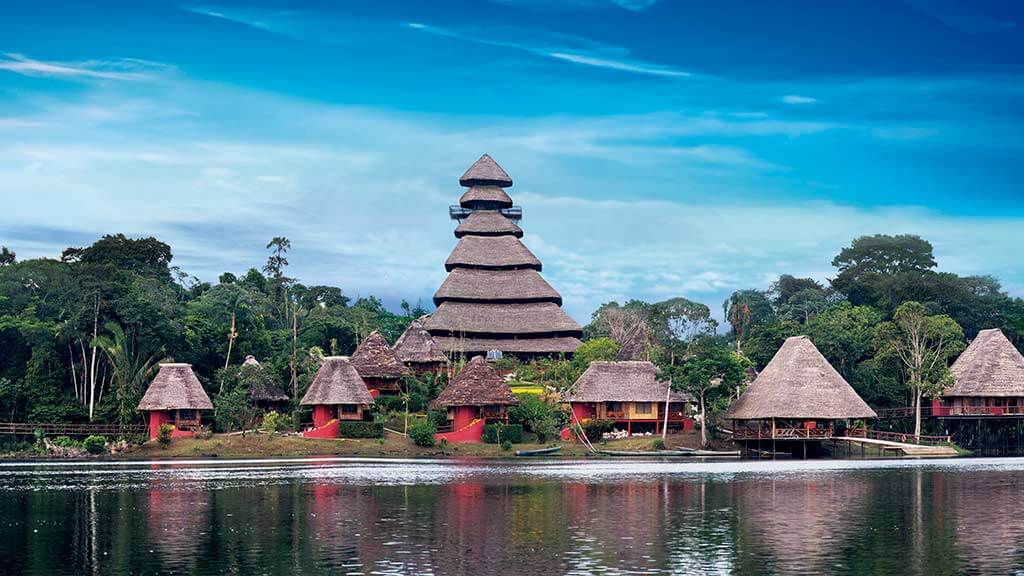
A common question we receive is: Which area is best, Cuyabeno or Yasuni? In truth, there is no right or wrong answer. Both offer a diverse and deep jungle experience, albeit in different rainforest habitats (flooded forest vs. terra-firma). The wildlife sightings in both areas are exceptional, and the mix of activities is often similar too.
So, what is the biggest difference between Cuyabeno and Yasuni? I would say that Cuyabeno is a cheaper way to visit Ecuador’s Amazon, most suitable for backpackers and budget travelers. The lodges at Yasuni, in contrast, tend to be at the pricier end of the scale, offering more comfort and better amenities.
At the end of the day, the choice is yours. Either way, I guarantee that Ecuador’s Amazon is not an experience you’ll want to miss!

Book with The #1 Trusted
Ecuador Travel Agency
Contact us for a free tour quote – Happy Gringo specialize in custom-made trips right across Ecuador, Galapagos and the Amazon. We’ll be happy to include an unforgettable trip to Cuyabeno Wildlife Reserve in a vacation itinerary for you.
In summary, Cuyabeno Reserve and the Amazon region are some of the very top visitor highlights in Ecuador. Whether you're an avid nature enthusiast, a wildlife lover, or simply someone seeking a breathtaking escape, the Cuyabeno Wildlife Reserve has something magical to offer. Prepare to be blown away by the flora, fauna, and cultural tribal activities. Cuyabeno Ecuador is highly recommended for the ultimate Amazon experience, without having to break the bank.

